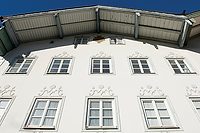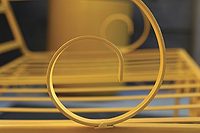Nano Structured Coatings with High Wear Resistance and Superior Photostability/Weatherability

In this paper, commercial organic lacquers and epoxy resins have been modified by the addition of nanoparticles to improve the key properties of scratch and wear resistance as well as photostability/weatherability. This new method has the advantage, in that it starts from existing, well-developed formulations to which a sol containing nanoparticles is added. After curing, the modified systems give transparent coatings with high wear and scratch resistance, combined with superior photostability and weatherability. Several examples will be used to illustrate the variety of application fields.
For a long time it has been desirable to combine the properties of organic compounds, e.g. flexibility and low moulding temperatures, with inorganic compounds, e.g. hardness and weatherability. Inorganic particles have been widely used as fillers or additives in the polymer industry.1 About 20 years ago, the dream became a reality with the possibility of synthesizing materials where the homogeneity between the organic and the inorganic parts could be controlled at the molecular level - so-called hybrid organic-inorganics.

Hybrid Organic-Inorganic Materials
Hybrid organic-inorganic materials and their synthesis have recently been reviewed.2,3 New approaches have been described, where it was shown that various types of clusters or nanoparticles could be formed.Usually hybrid organic-inorganic materials are classified into two main categories, depending on the type of bonding between the organic and the inorganic parts. Class I comprises all types of compositions where the bonds are not covalent, whereas class II incorporates compounds where organic and inorganic parts are linked by covalent bonds.
Very often, hybrid materials are produced by sol-gel.4 The most common way to produce nanocomposites is to form, in-situ, an inorganic phase by hydrolysis and condensation of alkoxides or alkoxysilanes. A further curing, resulting in covalent bonding between the organic and the inorganic phase, is usually achieved.5-7

Improvement of Mechanical Properties of Polymers
The addition of nanoparticle formulations to polymer materials often provides synergistic effects with commonly used stabilizers such as antioxidants, UV-absorbers and radical scavengers. A combination of stabilizers and nanoparticles in polymer materials often provides:- lower yellowing;
- superior retention of mechanical properties; and
- less or no leakage of degradation products when compared with materials that contain either nanoparticles or stabilizers.

Market Challenges
The industrial coatings market is undergoing substantial change. These changes are driven predominately by environmental regulations. Based on this background, coatings with improved lifetime performance offer new possibilities. Cost-effective nanoparticle-modified coatings could represent a significant competitive market edge for products.12
This paper describes the application of a new process to make nanoparticles and to incorporate them in existing systems. By this manner, organic-based coatings with improved scratch and wear resistance, and light stability can be prepared. The process is especially of interest for clear coatings. In addition to the improved wear resistance and light stability, other properties of the organic coating are retained, e.g. good corrosion, high flexibility and low cost.

Experimental Synthesis
Nanoparticle formulations were prepared by known sol-gel procedures and with commercial silanes as starting materials. After appropriate modification, the nanoparticle formulations were added to a commercial acrylic lacquer as well as to different epoxy hardeners and epoxy resins.The acrylic lacquer is based on an acrylate/ melamine/isocyanate system with acid-induced thermal curing. After addition of the nanoparticle formulations to the original lacquer, the mixture was equilibrated with stirring for 20 h at 40 deg C. Commercial aluminum plates were coated with the modified lacquer and cured for 1 min at 240 deg C.
The epoxy hardeners, which have been modified, are low-viscous liquids based on aliphatic and aromatic amines. Typical compounds are shown in Schemes (1) and (2) for ambient curing of epoxy resins.
Appropriate nanoparticle formulations were added to the original epoxy hardeners. The epoxy resins used are based on bisphenol A and bisphenol F diglycidyl ethers (Scheme 3).
Some resins are modified with reactive diluents (Schemes 4 and 5).
After addition of the nanoparticle formulations to the original epoxy resin, the mixture was equilibrated with stirring for 20 h at 40 deg C.
Ambient-temperature-cured epoxy samples have been prepared from either modified epoxy hardeners and original epoxy resins or original epoxy hardeners and modified epoxy resins. The amount of hardener was 30-50 phr.

Characterization and Testing
Particle Size and Size Distribution in the SolsParticle size and size distribution in the sol was measured with a commercial instrument, "Zetasizer 3" from Malvern, UK, based on light scattering. The particle size distribution was sharp, and the average particle size was 5 nm.
Scratch Resistance
The scratch resistance was tested with a Universal Wear Testing Machine from Eyre/Biceri, USA. The movable test sample was placed on the board with a constant weight of 600 g, and the apparatus was started. The number of runs was automatically counted. After 80 turns the surface was observed.
The scratch resistance was also measured with the help of a hardness pen of the type Erichsen (Erichsen, Tyskland). The method consists of making a scratch with the hardness pen; the force applied being controlled by a spring. The hardness value correlated to the force is read from the pen.
Wear Resistance
The wear-resistance properties were measured by means of a taber abrader according to ISO standard D 4060-95. The method comprises exposing the lacquered surface to wear by means of a rubber wheel rotating on the sample. The number of turns is automatically registered (1000 turns), and the force is determined by a known weight (500 g). The sheets are weighed before and after the test.
Shore Hardness
Shore D was measured according to ASTM D 2240 (ISO 868). Sample plates with 3 mm thickness were used.
Accelerated Weathering
Accelerated weathering of the epoxy samples was performed according to ASTM G 154 (ISO 4892-3) in an Atlas UVCON weather-ometer (Atlas Inc., USA). Fluorescent lamps of the type UVA-340 were used. The weathering cycle consisted of 4 hours of UV-light at 60 deg C; 0.5 hours of water spray at ca. 10 deg C; 3.5 hours condensing at 40 deg C before repeating.
Before and after accelerated weathering, the color of the samples was visually determined by comparison with Gardner standard colors (Gardner Colour Scale / ASTM D 1544).
Additionally, the samples have been visually checked for surface changes. All exposed surfaces have been wiped with methanol-wetted lens-cleaning tissues (Whatman Ltd, UK). Surface changes observed by this procedure quickly indicate gloss reduction and surface degradation.
Results and Discussion Room-Temperature-Curing Applications (Epoxy Samples)
A large number of epoxy hardeners and some epoxy resins have been modified with nanoparticles. Due to cost/performance considerations, only one component of the two-component system epoxy hardener/epoxy resin was modified in each trial. This procedure provides the possibility of keeping the hardener/resin ratio and other curing conditions close to the curing conditions of the original epoxy systems.
The accelerated weathering test results of two modified epoxy systems (modified 1 and 2) and two commercial epoxy systems (commercial 1 and 2) are presented in the tables. Table 1 contains information on the epoxy systems. Table 2 contains the results. The modified epoxy systems show a significantly better weatherability than the commercial samples. Figure 1 shows pictures of the sample plates Modified 1, Commercial 1 and Commercial 2.
The sample plates have been tested for wear properties. The number of scratches that appeared on the commercial plates was rather high. On the modified plates virtually no scratches were visible.
The same samples were tested by hardness pen. Parallel measurements showed that the force to make scratches on the plate made from Modified 1 was 20 N. In comparison, parallel measurements on plates based on the commercial epoxy qualities showed scratches already 0.2 N as shown in Figure 2. Shore D measurements show no significant differences between the commercial and the modified qualities. (Figure 3)

High-Temperature Curing Example of Acrylic Lacquers
A taber abrader was used to test cured acrylic coatings. Figure 4 compares results obtained from the non-modified acrylic lacquer with the same lacquer modified with nanoparticles. Completely clear-coated samples are obtained. After 1000 cycles, the weight loss is about 10 times lower with the modified lacquer compared with the original lacquer. A comparison is also made with anodized aluminum where the surface is covered with aluminum oxide. It appears that the weight loss on anodized aluminum and modified lacquer are fairly close to each other.Conclusion
Modification of high-volume commercial resins with nanoparticle formulation is feasible. Cost-effective improvement of the key properties of wear resistance and weatherability can be achieved.Fore more information, contact Dr. Christian Simon, Sintef, P.O. Box 124 Blindern, 0314 Oslo, Norway; phone +0047 2206 7524; fax +0047 2206 7350; or e-mail Christian.R.Simon@sintef.no.
Acknowledgements
The author would like to thank the co-authors of this article, which include Ferdinand M„nnle, Keith Redford and Rune Gaarder. Jest Beylich, Britt Sommer, Kjell Windsland, Mona Schartum are greatly acknowledged for their contribution in sample preparation and characterization.
This paper was presented at the 7th Nurnberg Congress, European Coatings Show, April 2003, Nurnberg, Germany.
References
1 Zweifel, H., Ed. Plastic Additives Handbook; Hanser, M¿nchen, 2000.2 Pomogailo, A.D. Russ. Chem. Rev. 69 (1), 2000, 53-80.
3 Sanchez, C.; de A.A. Soler-Illia, G.J.; Ribot, F.; Lalot, T.; Mayer, C.R.; and Cabuil, V. Chem. Mater. 13, 2001.
4 Adebahr, T. Proceedings of the 6th N¿rnberg Congress, N¿rnberg, Germany, 2001, 95-107.
5 Rozes, L.; Mammeri, F.; LeBourhis, E.; and Sanchez, C. Proceedings of the Conf. Organic-Inorganic Hybrids, Guilford UK, 2002, Paper 31.
6 Spirkova, M.; Brus, J.; Hlavata, D.; Kamisova, H.; Matejka, L.; and Strachota, A. Proceedings of the Conf. Organic-Inorganic Hybrids, Guilford UK, 2002, Paper 12.
7 Wagner, G. Proceedings of the Conf. Organic-Inorganic Hybrids, Guilford UK, 2002, Paper 14.
8 Taylor, A. Proceedings of the Conf. Organic-Inorganic Hybrids, Guilford UK, 2000, Paper 29.
9 Davis, S.R. Proceedings of the Conf. Organic-Inorganic Hybrids, Guilford UK, 2000, Paper 23.
10 Frahn, S.; Valter, V.; and Leder, G. Proceedings of the 6th N¿rnberg Congress, N¿rnberg, Germany, 2001, 145-156.
11 Parry, G. Proceedings of the Conf. Organic-Inorganic Hybrids, Guilford UK, 2000, Paper 3.
12 Arkles, B. Chemtech, 12 1999, 7-14.
Looking for a reprint of this article?
From high-res PDFs to custom plaques, order your copy today!





